
4 Ajaw 18 Kumk’u (March 24, 2022)
Haz clic aquí para leer en español
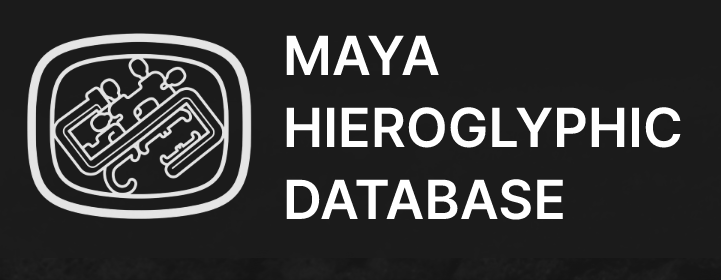
4 Ajaw 18 Kumk’u (March 24, 2022)
The Maya Hieroglyphic Database Online:
Revolutionizing Access and Democratizing Decipherment
Today, we find ourselves on a day 4 Ajaw in the winal of Kumk’u, echoing the familiar base date of the Long Count itself on 4 Ajaw 8 Kumk’u, several thousand years ago. Depending on the calendar correlation we use, we are also just about a week away from the date of the Classic Haab New Year on 0 Pop—a day which continuously rotates through the seasons by one day earlier every four years.
It is important to mention that the ways in which different Maya people have celebrated and commemorated the new year itself have varied at different times and places, and that the Classic Haab New Year of 0 Pop is not the same thing as the beginning of the agricultural year or cycle that I mentioned last month, which is more closely tied to the seasons and evident in several Maya groups. I had an important conversation with Hector Xol following my last blog about the evidence for the agricultural new year, and I realized that I should have explained a bit more about the variations in the ways that living Maya people recognize different new year celebrations, and how citing only non-Maya anthropologists and archaeologists can come across as arrogantly ignoring the voices of living Maya people.
Of course, as outsiders who rely on partial accounts from the ethnographic and epigraphic records, we must always be cautious to avoid asserting that there was just one “correct” way that Maya people celebrated new cycle events in different times and places. Maya people speak some 30 different languages, each with their own variations on the yearly calendar, and with differing amounts of overlap. We must also remember that there are many living Maya people who continue to keep their traditions very much alive, and they need not change them to conform to any one, reconstructed version from epigraphers or archaeologists. I find that it is from the dialogue between us that we all stand to benefit, and both Maya and non-Maya scholars have much to contribute and learn from one another in our collective exploration and understanding of the past.
Indeed, what we know of the Classic Maya Haab calendar is that it drifted throughout the year by one day every four years. With the imposition of the European calendar, the various different yearly calendars among different Maya peoples became frozen to the tropical year at specific times and places. Yet, agricultural traditions certainly persisted, and the 260-day count continued among several Maya groups, as it continues today.
While we may see slight differences in correlation when we look at astronomical evidence from the inscriptions, such as the potential eclipse reference from Santa Elena Poco Uinic, I don’t think that this conflicting information should cause anyone to abandon their traditional counts. It is not anyone’s place as an outsider to tell another how they should or shouldn’t observe their traditions. Instead, I take it as my role as an epigrapher, an archaeoastronomer, and a teacher to ask questions, look at the evidence, and to help collaborate on figuring things out, while also working with living Maya people, learning from them, and helping them to learn about and access information about the Maya past so that they, too, can contribute to the field while also maintaining and nurturing their own special connection to their own past, their own languages, and their own cultural traditions. Sometimes, I may stumble awkwardly, as we all do, but I remain committed to these goals.
In that regard, I am very happy to announce the recent release of the online Maya Hieroglyphic Database! This project stands to revolutionize and democratize decipherment by providing free access to the entire corpus of Maya inscriptions in a single, searchable database. This project was first initiated by Martha Macri and Matthew Looper at the University of California, Davis, and it has spanned four decades of work. With major contributions by Ruth Krochock, Yuriy Polyukhovych, and Gabrielle Vail, it has been a collective effort and collaboration among many contributors. For the past 21 years, I have had privileged access to the database as a research assistant, preparing images and contributing along with many others as a coder, and it was through this work that I learned to read and decipher Maya glyphs. I continue to use the database regularly in my research, and I am thrilled that it is finally available for everyone to use!
Currently housed at California State University, Chico under director Matthew Looper, the database is necessarily a work in progress, in that newly discovered inscriptions continue to be added, including unpublished inscriptions found only in museums. Likewise, the database makes collaborative decipherment much easier, while the process of decipherment is an ongoing process as errors are corrected, and new insights provide new decipherments.
The database now holds 207,539 separate grapheme entries, and 85,565 individual glyph block entries, including texts from the monumental inscriptions, the vases, and three of the surviving codices. It includes a searchable catalog of glyphs, as well as individual databases for separate searches in the Classic inscriptions and the codices, both by glyph block, and by individual grapheme.
You can access the Maya Hieroglyphic Database at the following address:
Please note that the MHD is only for desktop or laptop computers, and not yet available as a mobile application.
First, you will need to log in and verify your login through your email. Be sure to look in your spam folder in case the verification email is sent there.
You can find some helpful users guides and videos that Matthew Looper has posted at the following blog:
http://mlooper.yourweb.csuchico.edu/MHD/
There are also several reference documents (Reports 71-75) you can download from Glyph Dwellers:
I will provide an introductory search guide with screenshots below.
As it stands, the database is currently only available in English, and one of the next phases of the project will be to create a Spanish-language version that will allow many Maya people more immediate access. This will be a huge undertaking, and through a potential collaboration between the MHD and MAM, we hope to contribute to the release of the Spanish-language version of the database online in the future.
If you do notice any errors or have any questions about how the database works, please feel free to reach out to Matthew Looper:
In addition, I would be more than happy to help answer any questions you may have about how to use the database. Please feel free to reach out to me as well:
May this revolutionary database be a gift to the world, and especially to the Maya people whose ancestors were the authors of these beautiful texts.
Happy Deciphering!
Michael Grofe, President
MAM
Maya Hieroglyphic Database – Introductory Search Examples
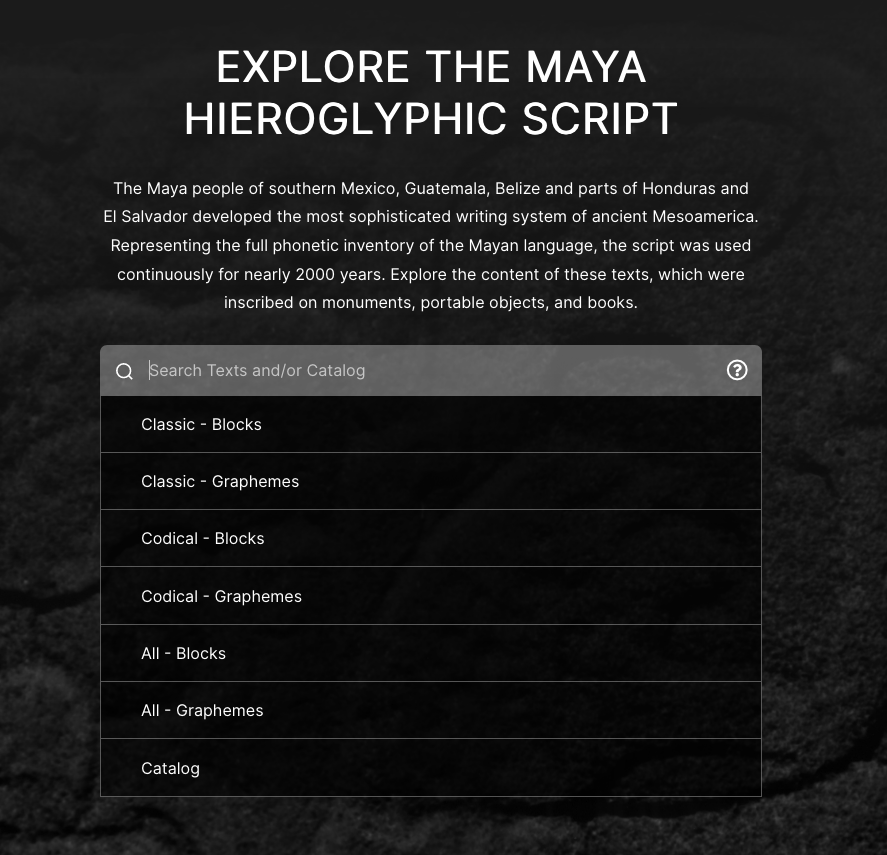
As a simple introduction to the database, we can begin with the a specific monument. Given that I contributed my drawing of Copan Stela A to the database, let me show you how to search for that text. On the home page, click on “Search Texts and/or Catalog” and scroll down to the bottom of the drop-down menu to click on “Classic – Graphemes”. This will give you a glyph by glyph analysis and familiarize you with the catalog codes. Alternately, choosing “Classic –Blocks” will provide reading based on entire glyph blocks.
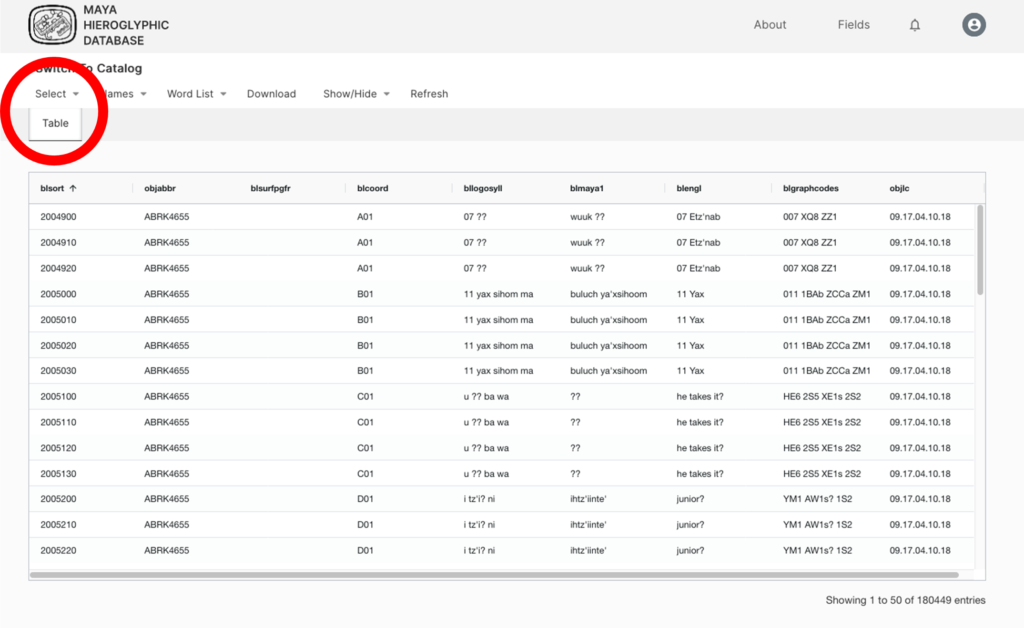
In the upper left corner of the search page, click “Select”, and a search tab opens up with “objabbr” and “Contains” already selected for you. Click where it says “objabbr”, and select “objsiteorig” (object site origin) from the drop-down menu. Then where it says “Keyword” write in “Copan” and click “Add”.
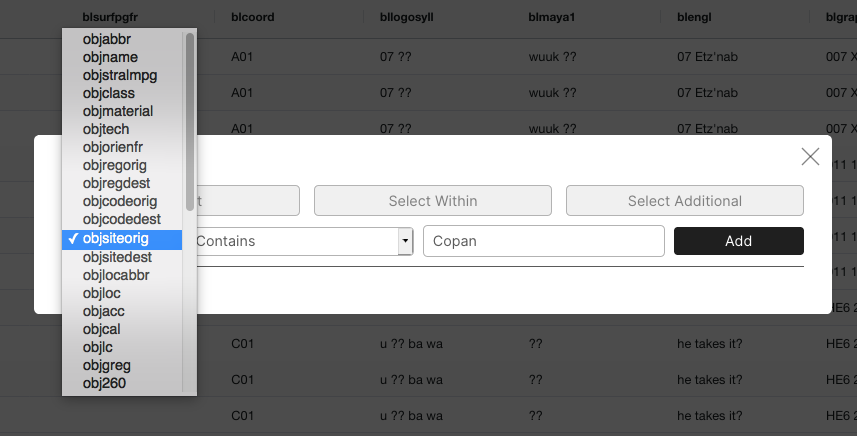
Then, go to the drop-down menu again and select “objname” (object name), and where it says “Keyword” write in “Stela A” and click “Add”.
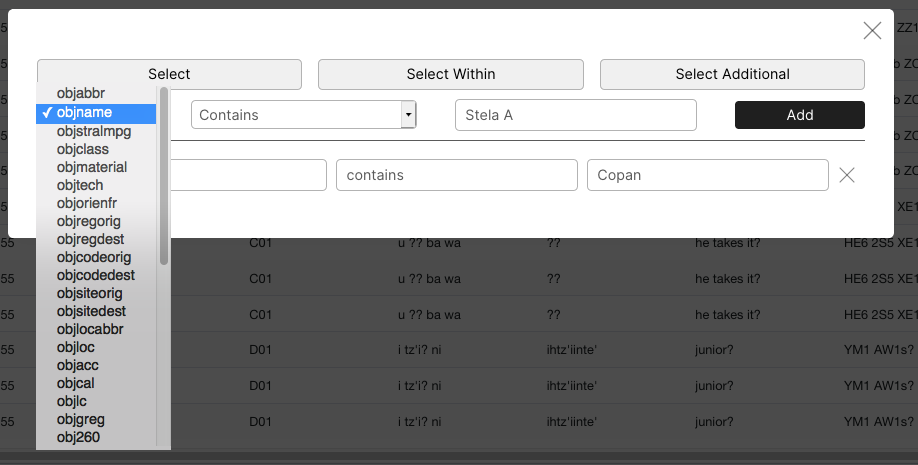
Go to the upper left of the search tab and click “Select”, and then the entire text of Copan Stela A will appear as text data.
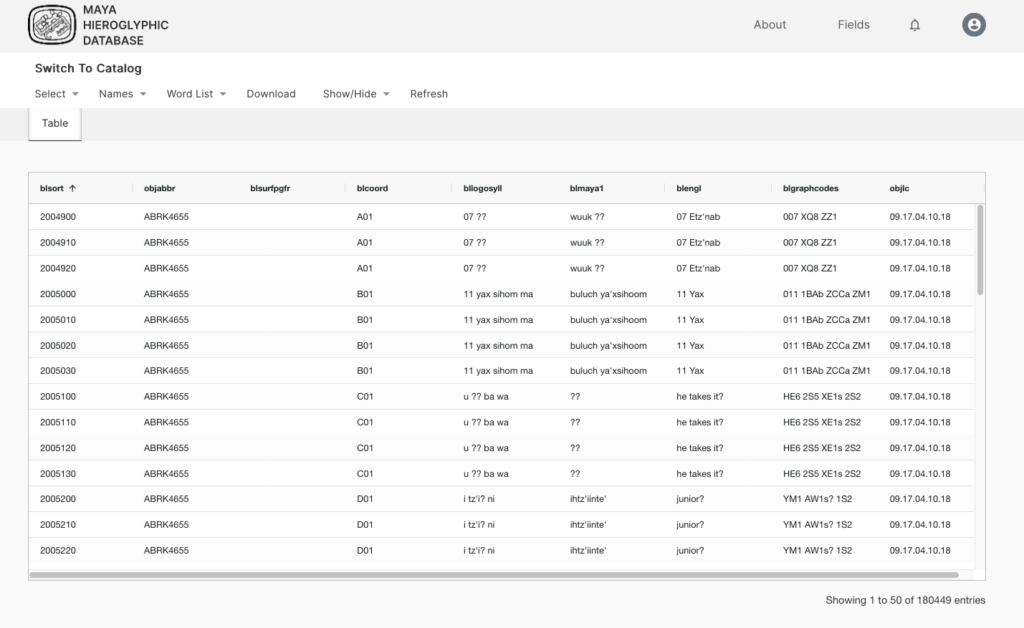
Clicking on the top line will take you to the beginning of the text, with drawings of the glyph blocks, transcription of the each of the graphemes, and grapheme codes (gr code) that can be used to search in the catalog and in the rest of the database. Scrolling down, you will see chronological information containing the Maya dates and calendrical data, all of which are searchable.

Beneath the drawing of the glyph block, a low resolution image of the monument is included.
If you click “Search Catalog” then it will bring you to a helpful catalog page for this specific glyph, including references and other examples, but note that you will lose your place within the text of Stela A and have to re-initiate the search to return to your place.
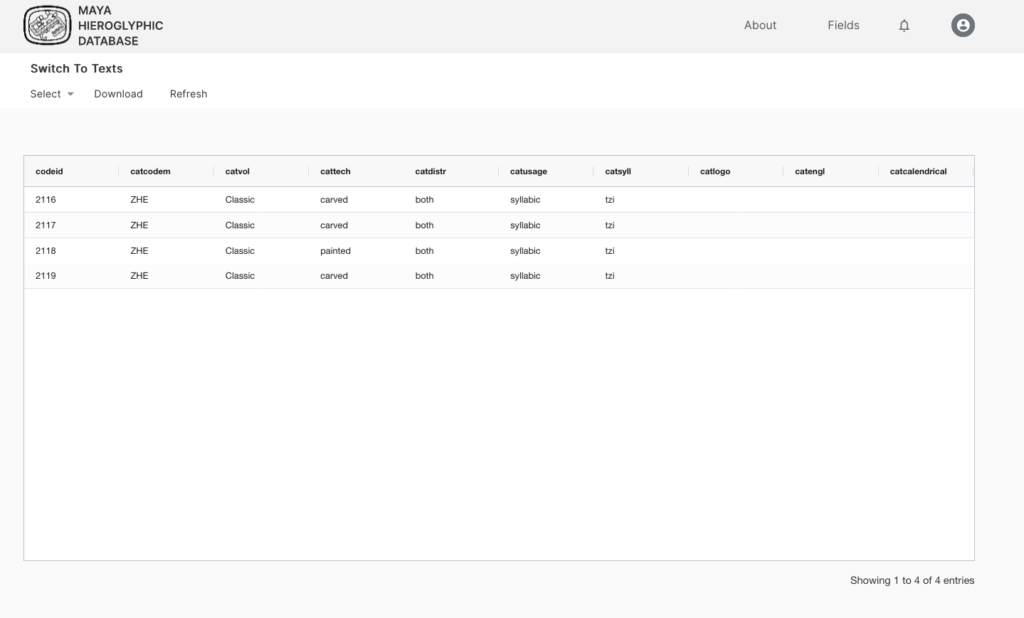
Pages of the catalog for the glyph ZHE “tzi”
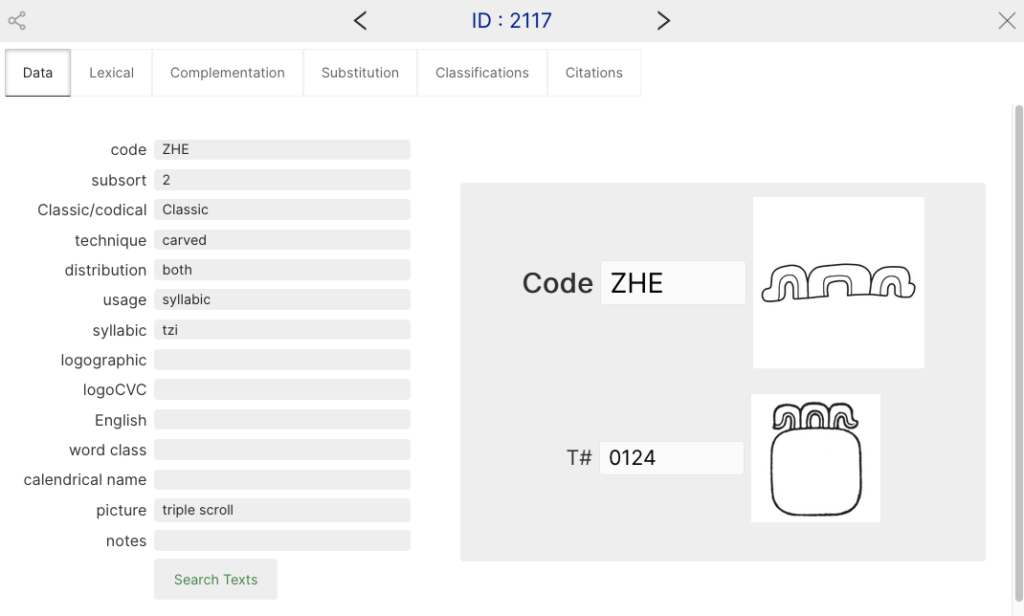
Resuming with the text for Copan Stela A, clicking on the right arrow at the top of the frame will take you to the next grapheme in the glyph block, and then to subsequent glyph blocks.
Noting under the category “semantic” in this first glyph block, we see “ISIG/Kumk’u”, since this is the Initial Series Introductory Glyph with the Haab patron for the winal of Kumk’u. If you now want to search for all of the examples of the ISIG throughout the inscriptions, it is easier to do this by going back to the home page and selecting “Classic – Blocks”. This way, it will not take as long to load so many individual grapheme records. Then return to the upper left corner of the search page, click “Select”, and a search tab opens up again. Click where it says “objabbr”, and select “blsem” (block semantic) on the drop-down menu. Then where it says “Keyword” write in “ISIG”, and click “Add”. Click “Select” and then all of the examples of the ISIG throughout the inscriptions will appear! Clicking on the top line will show you the ISIG from Aguateca Stela 3. Note that some have not yet been drawn, but most are included.
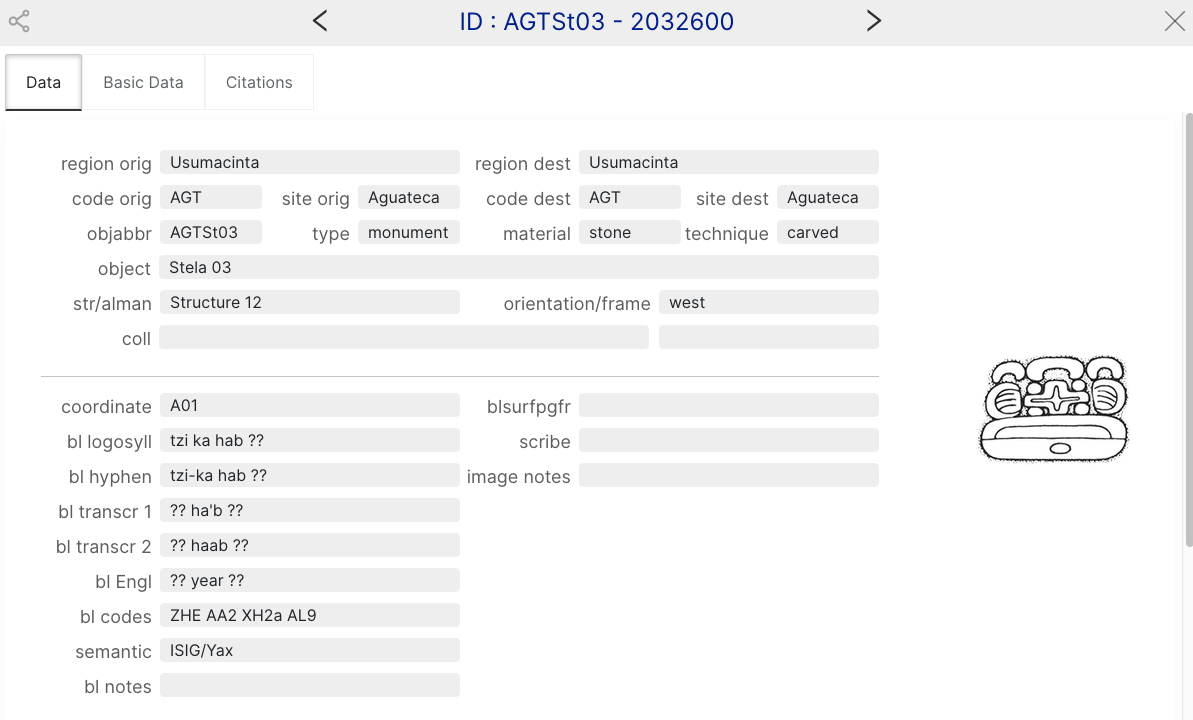
Note that it will load only 50 examples at a time, but scrolling down will add on the next 50 after waiting a few seconds. It will take a minute or so to load all 618 examples of the ISIG from the entire corpus.
If you want to sort all of the examples of the ISIG by long count date, then simply go back to the upper right corner of the data page, click on “objlc” (object long count), and it will sort all of these examples chronologically by their long count dates. Voilà!
For a more specific search for only those ISIG with the patron of Kumk’u, you could include just “ISIG/Kumk’u” in the “blsem” category, or you could additionally select ISIG glyphs by site under “objsiteorig”.
The possibilities are endless, and using this powerful new tool will help users become more proficient at reading and understanding Maya writing. Furthermore, it can lead you to identify new patterns that can lead to new insights and new decipherments!
Enjoy!!
If you wish to make a tax-deductible donation in any amount to support the MHD, please use this secure link:
http://www.csuchico.edu/givetomayaglyphdatabasefund
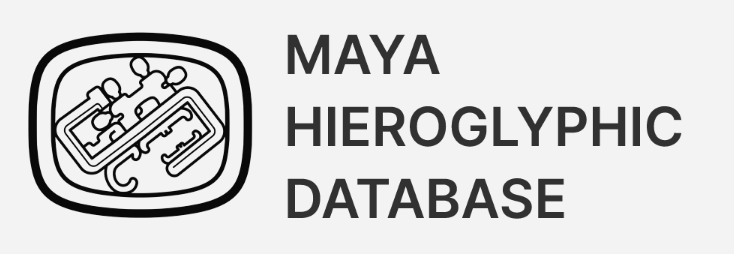

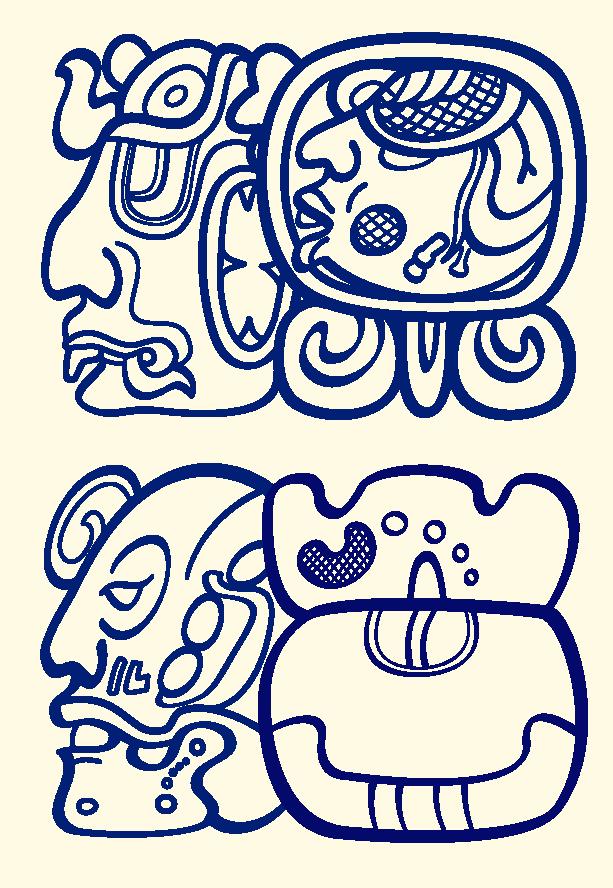
Pingback: 4 Ajaw 18 Kumk’u: Spanish | Discover MAM
This is fantastic! Huge thanks to Martha, Matt, Ruth, Yuri, Gabrielle. I particularly look forward to the Spanish language version so that our esteemed colleagues such Hector and others can more easily their insights.
Pingback: Maya Hieroglyphic Database